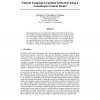Free Online Productivity Tools
i2Speak
i2Symbol
i2OCR
iTex2Img
iWeb2Print
iWeb2Shot
i2Type
iPdf2Split
iPdf2Merge
i2Bopomofo
i2Arabic
i2Style
i2Image
i2PDF
iLatex2Rtf
Sci2ools
NIPS
2001
2001
Natural Language Grammar Induction Using a Constituent-Context Model
This paper presents a novel approach to the unsupervised learning of syntactic analyses of natural language text. Most previous work has focused on maximizing likelihood according to generative PCFG models. In contrast, we employ a simpler probabilistic model over trees based directly on constituent identity and linear context, and use an EM-like iterative procedure to induce structure. This method produces much higher quality analyses, giving the best published results on the ATIS dataset. 1 Overview To enable a wide range of subsequent tasks, human language sentences are standardly given tree-structure analyses, wherein the nodes in a tree dominate contiguous spans of words called constituents, as in figure 1(a). Constituents are the linguistically coherent units in the sentence, and are usually labeled with a constituent category, such as noun phrase (NP) or verb phrase (VP). An aim of grammar induction systems is to figure out, given just the sentences in a corpus S, what tree str...
| Added | 31 Oct 2010 |
| Updated | 31 Oct 2010 |
| Type | Conference |
| Year | 2001 |
| Where | NIPS |
| Authors | Dan Klein, Christopher D. Manning |
Comments (0)

